
See also:

![]()
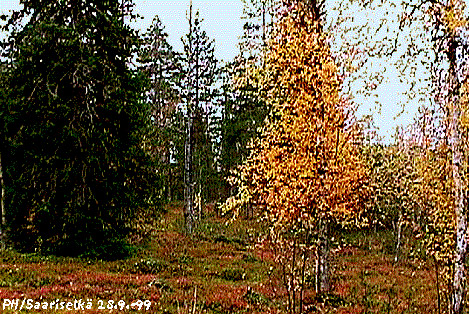
In the fjeld areas of Saariselkä, a great blaze of autumnal colours is often seen in the mid-September:
autumnal colours of the ground and autumnal colours of trees, and the colours shine far away…
Definitions of autumn
During the autumnal equinox (approximately 23.9), night reaches the length of day, and it will often be quite dark already during the day.
From the beginning of September onwards, at the latest, the temperature falls slowly, and it feels as if it rains all the time. However, usually the rainfall does not increase after August as cloudiness, fogginess, and air humidity do. In September-October, there are rapid changes in the weather. High and low compete for living space – often stormily. In the mid-October, the average temperature falls below zero in the Northern Finland (in Inari 11.10, in Rovaniemi 15.10, in Kajaani 24.10). In the past, the season ended at this time and the indoor feeding of the cattle began. Some time in the past, even the year ended at Michaelmas (10.10). The closing ceremony of the season was held at All Saints’ Day (1.11). Officially, winter will begin when the average temperature is permanently below zero. Compare with winter!
Autumn of plants
Growing season is of different length with different species, and it ends at different times. Of course, the seeds and new buds should be ready before the end of the growing season. With some species, the growth continues to late autumn – up to the arrival of frost. Some weeds have not adapted to the arrival of winter at all, but continue growing till the frost arrives, and even flower a second time in autumn, and continue their growth immediately after they have got rid of the snow cover in spring.
The main group of plants stops growing in July-August at the latest. After that – and even before – begins the preparation for winter. Hibernacula develop, and energy and nutrients (produced in photosynthesis) are stored (in the cell tissues of the stem and/or the roots). This is to ensure that the plants survive winter and have something to begin with the next summer… In spring, a quick starts is necessary - summer is short!
Overwintering of plants
Despite the various problems that winter has caused for natural plants they have a need to go through wintertime (= vernalization). To start their growth in spring they need at least a few weeks long cold treatment. The same applies to the germination of seeds of many plants. The term vernalization is often used to speed up the growth of plants with cold-treatment (or hormonal treatment).
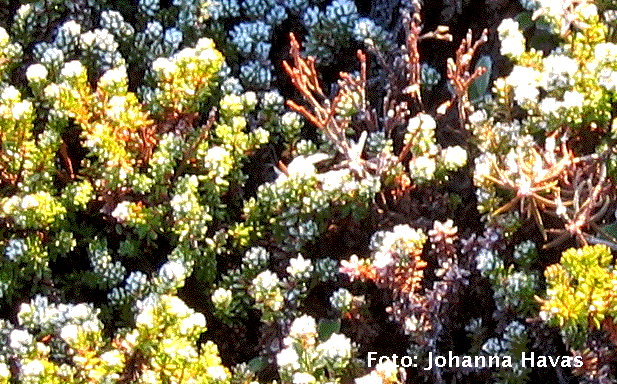
Nightfrost has affected hoar-frost to the tops of alpine plants. Dominant species here is crowberry
(Empetrum nigrum ssp. hermaphroditum). There are no autumn colors in the leaves of this plant
but they are overwintering.
What the overwintering of plants means...
• The increase in the temperature sum leads to beginning of overvintering... • The shortening of day and clear autumn weather brings the blaze of autumn colors... • Autumn colds “club” the plants into dormancy… • The soil has some effects on overwintering, too… • On the level of cells, many changes take place in the autumn… • Some northern plant species “demand” an experience of winter. |
For plants, winter means first and foremost the tolerance of cold and dryness.
Preparation for the changes in tolerance (resistance), i.e. for overwintering, begins in late summer at the end of growth when the hibernacula are completed, some parts of the plant die, and various changes take place on the cell level. All this preparation is called overwintering.
Special changes in the environment synchronise overwintering: Temperature sum accumulates, night lengthens, and temperature falls; the plants have to acclimatize to all this. Furthermore, the genes of a species/individual direct overwintering: thus, what kind of environment it has adapted to in the course of years.
A Finnish professor Risto Sarvas has described the annual developmental rhythm of trees in three phases: active stage, autumn dormancy, and winter dormancy. Sarvas claimed that this rhythm is taken care of by the “inner clock” of a plant, which is synchronised by the accumulation of temperature sum in particular. When a certain ‘amount’ of temperature has accumulated in the habitat, the inner clock of the plant recognises the situation and changes the rhythm towards overwintering: the growth comes to an end, buds complete, and winter stores are gathered up.
The accumulation of temperature sum as such is not enough to explain the whole event of overwintering but the plants react also to some other signals in the environment in autumn. The length of the day, or more specifically the shortening of the day and – first of all – the lengthening of the night at the same time in autumn have an important role in the timing of overwintering of northern plants (compare with the time of autumnal colours later!). The shortening of the day leads to autumn dormancy when the actual hardening for winter begins. During the winter dormancy, the level of hardening may deepen depending on the species.
Cold-resistance starts to grow already in late summer, e.g. with our coniferous trees several weeks before hard frosts. Photosynthesis usually comes to an end by the time of frosty nights: in late autumn, photosynthesis does not take place even during the day, not even if the temperature rises above zero.
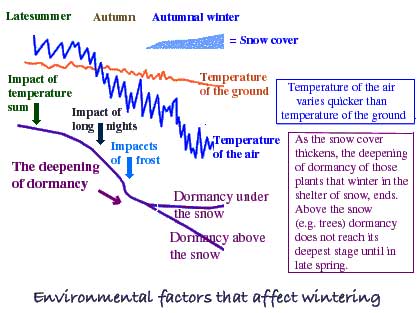
The plants’ final hardening for winter, i.e. sinking into winter dormancy, begins slowly with cool autumn nights and the lengthening of nights. Apparently, also dryness in late summer and in autumn increases the cold-resistance of several plants. Dry, barren and sunny heath forests (as well as bare mountaintops) are common in Finnish nature. Those places in particular are the places where several of our cold-resistant natural plants thrive. Moreover, the nutrient conditions of soil and plants affect overwintering in several ways. Especially, strong nitrogen fertilisation in autumn is dangerous: with the help of it, the plant may continue growing for too long without preparing for the arrival of winter on time. Also the saplings of forest trees that have been grown in nursery garden may have a lower cold-resistance than the saplings that grow in nature (in more barren conditions).
There is only scarce information of the overwintering of roots. Nevertheless, as the soil slowly cools down and eventually freezes, the taking of water and nutrients from the ground slows down. In general, the roots are more sensitive to cold than the superterranean parts of the plant. However, the roots are sheltered from cold in the cover of snow and humus layer.
The depth (and length) of winter dormancy varies according to species and depending on the coldness of winter. There is a group of plants that do not “understand” the approaching of winter. These plants include particularly those plants that have recently arrived in Finland, such as some weeds. Furthermore, several moss and lichen are in weak dormancy (they may “wake up” easily and quickly).
In the base of falling leaves may develop a so-called detached cell tissue, from which the leaf detaches itself easily, especially if ice develops into the cell tissue. Thus, cold furthers the falling off of leaves in late autumn. The needles of coniferous trees (the oldest needles) fall off in August-September, before the time of autumnal colours.
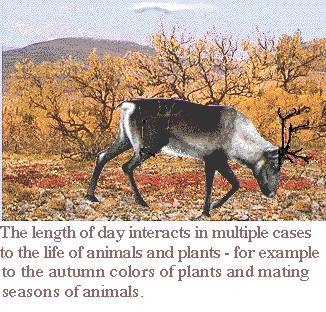

Autumn colours in Oulu, Linnanmaa in autumn -03. Blueberry and deciduous trees are in full colors!
Before the beginning of winter and the falling off of leaves, a great celebration of autumnal colours will take place in the north: plants “dress up” in red, purple and gold. The colours are even more intense on bare mountaintops and in northern fjeld birch groves. In meadows and bogs, the colours are more monotonous, even though made colourful with brown and reddish colours. Birches, European aspen, and rowan as well as many twigs, e.g. dwarf birch (Betula nana), bilberry (Vaccinium myrtillus), bog whortleberry (V. uliginosum), and bearberry (Arctostaphylos alpina) of the field layer (autumnal colours of the ground) take part in the display of colours.
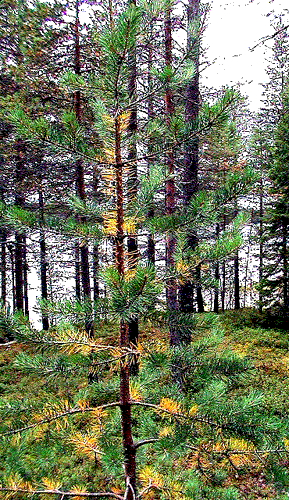
Autumnal colours of the ground come to Lapland somewhat earlier than the autumnal colours of the trees. However, the leaves of grey alder fall off while they are green. Coniferous trees shed their needles (once a year) as plain brown.
The time of autumnal colours is approximately the same every year in every town/latitude. It depends mainly on the length of day and night. The time of autumnal colours begin in the north: in Utsjoki, it is at its best around 10.9, in Kuusamo around 15.9, in Oulu around 20.9, and in the Southern Finland a week or two later. Humidity conditions (drought) of summer and early autumn may accelerate the schedule of autumnal colours. The plants that have been taken from one area to another, try to reach the time of autumnal colours according to the day length that they have been adapted to in their original habitat.
The day length is of vital significance as is shown by certain species (e.g. dwarf birch and bearberry) that develop their autumnal colours prematurely at least in Lapland if they experience a long night already in summer (they are covered with black plastic for a few nights). Near street lights – in a so-called long day - , the leaves of e.g. birch and maple remain green for a long time.
The reason for yellowish autumnal colours is that nitrogenous matter of chlorophyll is transferred from dying leaves to a safe place (e.g. in the upper parts of branches and in buds) for the winter. Thus, other pigments are then more visible. Nitrogen is scarce in our nature – we have to save it! The leaves have yellow xanthophyll pigment as well as reddish yellow carotene (compare with carrot!) even in summer, although they are covered by chlorophyll.
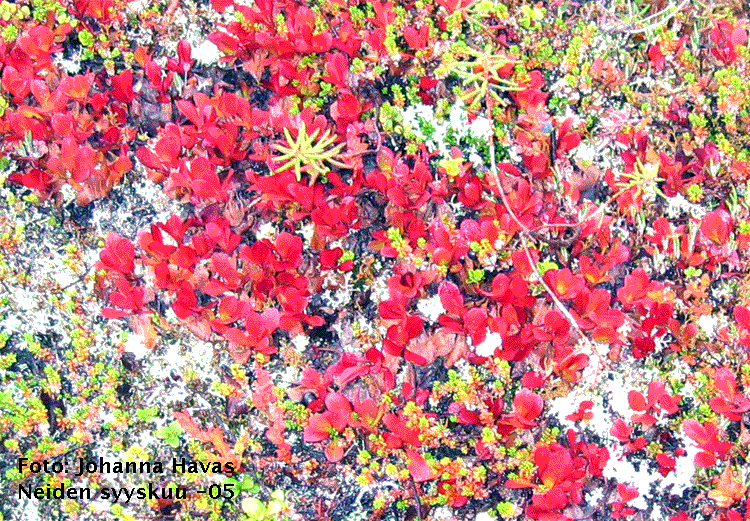
Some plant species living in tundra like vegetation, among others Arctostaphylos alpina, Ledum palustre and Empetrum nigrum ssp. hermaphroditum. In the leaves of Arctostaphylos alpina have very strong autumn color generated by anthocyan.
Between the winter and summer stages, the contents of cells have to endure changes that are dependent on seasons! Many important biochemical changes take place in plant cells during overwintering. As the “winter genes” activate, hormonal activities change and “winter enzymes” are developed.
The development of ice crystals in living cells is fatal so water must be extracted from the cells in autumn. Biochemistry of cell membranes changes in autumn so that water departs through the membrane, and the content of the cell concentrates. Furthermore, this signifies the drying of the cell tissues. If ice crystals break the cell membrane, the vital content of the cells flows into the space between cells –the cell dies!
In autumn, the starch in the cells is turned into easily soluble sugars. Moreover, there are changes in the amino acid composition of the cells. A so-called anti-freeze solution is developed in the cells. The task of the solution is to enhance the cold-resistance of the content of the cells. For example, in the cells of diapensia (Diapensia lapponica), which grows in the fjelds of Lapland, the starch turns into sugars already around the middle of August. The contents remain high all the way to spring. Furthermore, the protein contents rise in autumn. Certain soluble proteins (along with sugars) enhance the cold-resistance of the cells.
Autumn is the time of fungi...
The subterranean mycelia of fungi have been living a life hidden from the human eye during the summer (decaying plant remains and/or living in symbiosis with higher plants). In autumn, the fungi rise to the surface of the earth to spread their spores (fruit body, sporophore=a superterranean part of the fungus which spreads spores). The development of sporophores requires enough humidity and warmth – fungus crop varies from year to year. Many sporophores freeze easily during the cold nights in autumn. Nevertheless, new sporophores develop, and some fungus species can be found very late in autumn.